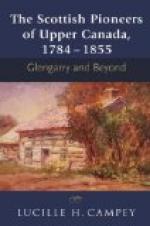Nova Scotia as a British colony also came into being as another result of these adventurous British expeditions to North America in the reign of James I. Under the name of Acadie this region had been declared to be a portion of New France by De Monts and Champlain in 1604-14. But the English colonists in 1614 drove the French out of the peninsula of Nova Scotia on the plea that it was a part of the discoveries made by the Cabots on behalf of the British Crown. In 1621 James I gave a grant of all this territory to Sir William Alexander under the name of Nova Scotia, and both Charles I and Cromwell encouraged settlement in this beautiful region. When Charles II ceded it to France in 1667 the English and Scottish colonists who were residing there, and the English settlers of New England, refused to recognize the effects of the Treaty of Breda, and so harassed the French in the years which followed that in 1713 Nova Scotia was, together with Newfoundland, recognized as belonging to Great Britain. The French colonists were allowed to remain, but during the course of the eighteenth century they combined with the Amerindians (who liked the French and disliked the British) and made the position of the British colonists so precarious that they were finally expelled and obliged to transfer themselves to Louisiana and Canada. This was the departure of the Acadians so touchingly described by Longfellow.
The British had become tenacious of their rights over the east coast of Newfoundland, because from the middle of the seventeenth century onwards they were becoming increasingly interested in the whale fisheries and the fur trade of the lands bordering on Hudson’s Bay, and would not tolerate any blocking of the sea route thither by the French.
In the explorations of Arctic America, Frobisher’s expeditions had been succeeded by those of JOHN DAVIS, who in the course of three voyages, beginning in June, 1585, passed the entrance of Hudson’s Straits and reached a point as far north as 72 deg. 41’, a lofty granite island, which he named Sanderson’s Hope. He saw beyond him a great sea, free, large, very salt, and blue, unobstructed by ice and of an unsearchable depth, and believed that he had completely discovered the eastern entrance of the North-West Passage.
[Illustration: ICEBERGS AND POLAR BEARS]
HENRY HUDSON, the great English navigator, who had made two voyages (1607-8) for the English-Moscovy Company to discover a north-east passage to India, past Siberia, commanded a third experiment in 1609 at the expense of the Dutch East India Company. He was to discover the North-West Passage. For this purpose he entered the river now named the Hudson, but soon found it was only a river; though he returned to Holland with such an encouraging account of the surrounding country that the Dutch a little later on, founded on the banks of the Hudson River their colony of New Amsterdam (afterwards the State of New York). In 1610 Hudson accepted a British commission




